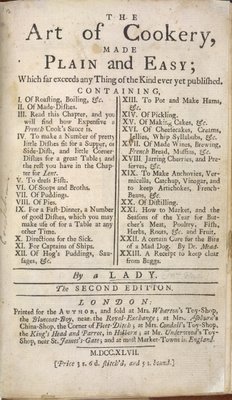 Louis Simond, An American in Regency England, describes a meal with his host and hostess as thus:
Louis Simond, An American in Regency England, describes a meal with his host and hostess as thus:"The master and mistress of the house sit at each end of the table--narrower and longer than the French tables--the mistress at the upper end--and the places near her are the places of honour. There are commonly two courses and a dessert. I shall venture to give a sketch of a moderate dinner for ten or twelve persons. Although contemporary readers may laugh, I flatter myself it may prove interesting in future ages."
First course (not in order)
Oyster Sauce, Fish, Fowls, Soup, Vegetables, Roasted or Boiled Beef, Spinage, Bacon, Vegetables
Second Course (not in order)
Creams, Ragout a la Francoise, Pastry, Cream, Cauliflowers, Game, Celery, Macaroni, Pastry.
Dessert (not in order)
Walnuts, Raisins and Almonds, Apples, Cakes, Pears, Raisins and Almonds, Oranges
"Soon after dinner the ladies retire, the mistress of the house rising first, while the men remain standing. left alone, they resume their seats, evidently more at ease, and the conversation takes a different turn--less reserved--and either graver, or more licentious."
Click on more links to food in the Regency Era:
Historic Food Links
The Food Timeline
Food and Drink in Regency England
The Art of Cookery
History of Tea in Britain
About the Art of Cookery: 'The Art of Cookery', written by Hannah Glasse, was published in 1747. It was a best seller for over a hundred years, and made Glasse one of the best-known cookery writers of the eighteenth century. As Glasse explains in the preface, the book was intended to be an instruction manual for servants - 'the lower sort' as she called them. During the 1700s there was a fashion for books of this kind, which were designed to save the lady of the house from the tedious duty of instructing her kitchen maids."

No comments:
Post a Comment